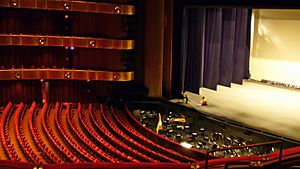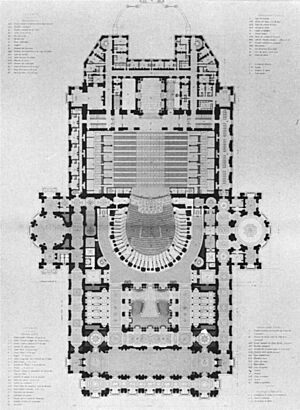Orchestra pit facts for kids
An orchestra pit is a special area in a theater. It's usually a lowered space right in front of the stage. This is where musicians play live music for shows.
Instead of being on the stage, the orchestra plays hidden away in the pit. This is common for opera and ballet shows. They also play when special background music, called incidental music, is needed. The conductor, who leads the musicians, usually stands at the front of the pit. They face the stage so they can see the performers.
Contents
Building an Orchestra Pit
How Pits Are Designed
The walls of an orchestra pit are built in a special way. This helps the sound of the orchestra spread perfectly. The music flows through the whole theater without being too loud for the stage. Many pits are also designed to keep sound levels low. This protects the musicians' hearing.
A small platform in the pit is usually for the conductor. This helps all the musicians see them clearly. Musicians might sit on chairs or on bleachers, depending on the pit's design. All kinds of musicians play here, from violinists to bass players.
Moving Pit Floors
Many modern orchestra pits have a special lift. This lift can move the pit floor up and down. It can go all the way down to a storage area under the stage. It can also stop halfway, level with the audience floor. Or, it can rise all the way up to be level with the stage.
When the lift is lowered, equipment or props can be loaded from below. Then, they can be lifted onto the stage. The pit can also be raised to floor level. This creates more seating for the audience. This is often done for rock concerts, where the pit area becomes a standing room. When the pit is raised to stage level, it adds more space to the stage. This is great for bigger shows. These moving pits give theaters lots of ways to adapt for different events.
Where Pits Can Be Located
Most people expect the orchestra pit to be in front of the stage. But an orchestra pit doesn't always have to be there. Sometimes, it's in another part of the theater. If it's elsewhere, the conductor's movements might be shown on monitors. This helps the actors on stage follow the music cues.
History of Orchestra Pits
Early Theater Yards
Long ago, in theater history (from 1500–1650), the orchestra pit was called the "yard." This was a lower area where people from the lower classes stood to watch plays. It was often very crowded, and it was hard to see the whole stage. The size of the yard changed with different theaters. Other audience members sat in regular seats where they could see everything.
Modern Pit Changes
Since those early days, the orchestra pit has changed a lot. It has been improved to work better with modern theater. Today's orchestra pits are designed much better. They also have many different uses, making them very flexible.
How Orchestra Pits Are Used Today
When an opera or musical is performed, live music is often needed. The orchestra pit is lowered, and the musicians play there. This way, the orchestra's director can see the stage. They get a better feel for when to start and stop the music. Sometimes, there are very specific sound effects needed. It's super important that these are played at just the right moment.
Playing in the pit can sometimes cause problems. There might not be enough space for all the musicians. Also, the sound quality can suffer. This happens because instruments' sounds can "bleed" into each other's microphones. This occurs when everyone is squeezed too close together.
Conductor's Viewpoint
Before the 1800s, the conductor stood at the edge of the stage. They faced both the audience and the orchestra. Their back was to the performers on stage. This is shown in the Palais Garnier orchestra pit plan.
However, in the late 1800s, this changed. Now, the conductor usually stands in front of the first row of the audience. Their back is to the audience. They face the orchestra and the performers on stage. This allows them to see everyone they need to direct.
See also
 In Spanish: Foso de orquesta para niños
In Spanish: Foso de orquesta para niños
- Pit orchestra
- Benshi



